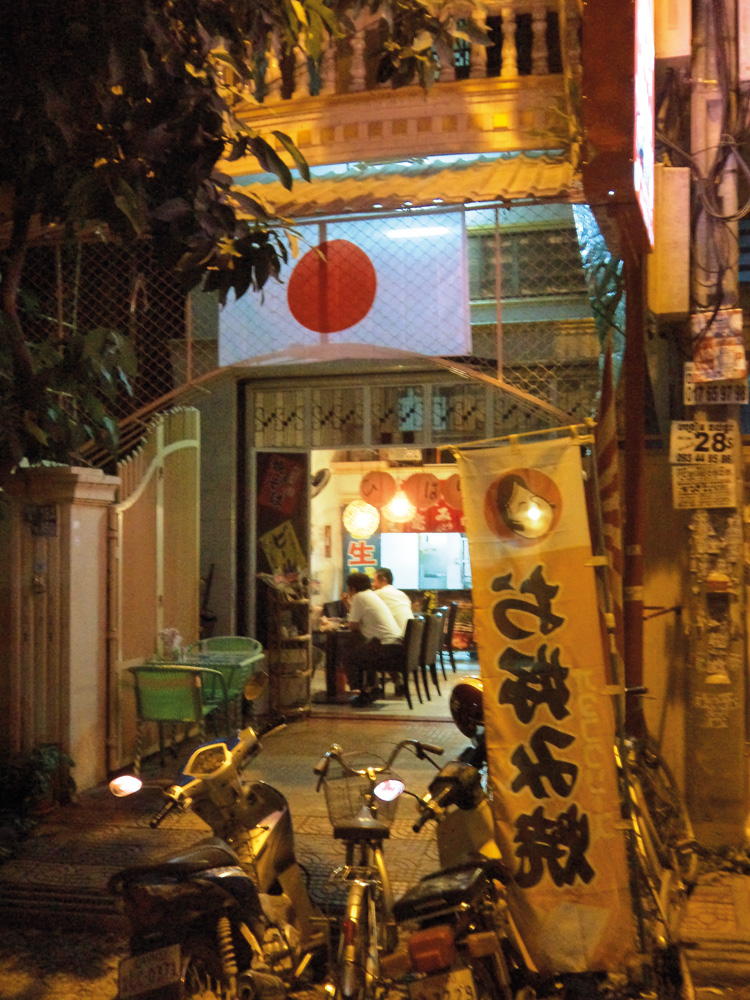A silent war is raging on the streets of Phnom Penh. No, it’s not moto vs. tuk tuk, Cambodia Beer vs. Angkor or anyone vs. the state. In this war there are no UN watchdogs, volunteer do-gooders or viral cyber campaigns. This “war” has a much different, yet still serious question, especially if you are of a Japanese persuasion. Namely, who produces the best okonomiyaki: Osaka or Hiroshima?
I have mentioned this dish in a past review so here are the briefest of details. Okonomiyaki is commonly referred to as Japanese pizza, although it resembles pizza in the same way that I resemble Johnny Depp: not very much. Closer to the mark is its other Western description, “savoury pancake.” All okonomiyaki share the same ingredients – flour, grated yam, dashi, eggs, shredded cabbage, and other variants that can include thin slices of squid, octopus, mochi and cheese. In both forms, these ingredients are cooked on a hot grill to produce a meal that is at odds with the traditional notion of Japanese food as carbo light, healthy and rice-centred. Okonomiyaki, most definitely, will never make any Weight Watchers “best dish” list. Yet, with two provincial variations, Osaka and the Hiroshima, chances are, there is an okonomiyaki that will satisfy your taste.
Ninja (St. 278) is the place to go if you wish to order okonomiyaki “Osaka style.” Prepared like a pancake, flour batter and the other ingredients are mixed and fried together to produce this version of the dish, which is then topped with mayonnaise and okonomiyaki sauce. This okonomiyaki is the stuff of food comas and carbo-overload: the perfect “night before” dish if running a marathon but not, I would suggest, an extended yoga session. In this way, it falls short of what we anticipate of Japanese food, but then this should be of no surprise, as Osaka has always bucked the trend of what one expects of Japan. Japanologist Alex Kerr sums up the city’s qualities well: “Few major cities of the developed world could match Osaka for the overall unattractiveness of its cityscape… yet Osaka is my favourite city in Japan. Osaka is where the fun is [while] Osaka people are impatient and love to disobey rules.” In brief, Osaka is like its okonomiyaki: they are the most un-Japanese of people and places.
So now, what about the Hiroshima version? For a few months I have been hearing about Hibari on St. 350. a whole in the wall style establishment near Toul Sleng, whose okonomiyaki numerous Japanese acquaintances have raved about. With my food guide “Ms. Morimoto” I ventured out to discover for myself. On the night we visited, Hibari was packed and, while we ate, the Phnom Penh version of the “Japanese Salary Man” continually trooped in: this place was popular! Better yet, with the okonomiyaki cooked on a hot grill at the open rear of the restaurant, it was possible to see the clear differences in preparation between the Hiroshima and Osaka styles of the dish. With the Hibari/Hiroshima style okonomiyaki – also known as Hiroshima-yaki – the ingredients are layered rather than mixed, and the tiers include the same constituents as the Osaka form, though the amount of cabbage used is much higher. The other key variation is the laying of soba or udon noodles as a topping, together with a fried egg, finished off with okonomiyaki sauce. Mayonnaise, however, is notably absent in the Hiroshima version.
The Hiroshima-yaki served at Hibari ($3-$4.50) was less filling than the Osaka version offered at Ninja ($4.50): definitely the okonomiyaki for the gal or guy watching his or her weight. Either way, both versions were delicious and with the two varieties now available in Phnom Penh there is no excuse for not giving this meal a try. Restaurant-wise, Ninja’s menu certainly outshines Hibari’s in terms of additional options, but as the line of constant Japanese business at Hibari suggests, this place carries a brand of authenticity and quality. In short, what it does, it does well.
Hibari, #18a St. 350, BKK3
Ninja, #14a St. 278, BKK
